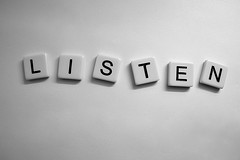 Last week I started a 3 part series on leadership development. In it, I said that, “in developing your leadership effectiveness you really only have 3 areas to impact – your thinking, your listening and your speaking. In this post, I will examine the second piece, your listening.
This series was inspired by my recent work with Vistage Malaysia where I spoke to 15 different groups of executives in the Kuala Lumpur, Malaysia area over a two week period.
Last week I started a 3 part series on leadership development. In it, I said that, “in developing your leadership effectiveness you really only have 3 areas to impact – your thinking, your listening and your speaking. In this post, I will examine the second piece, your listening.
This series was inspired by my recent work with Vistage Malaysia where I spoke to 15 different groups of executives in the Kuala Lumpur, Malaysia area over a two week period.
One of the key pieces we worked on in accelerating their leadership development was asking them to pay attention to and understand how they listen. This is something we work on with all of our clients, because we have found most have never realized that you can strongly influence another person's experience and behavior simply by taking charge of the way you listen to them.
The way we worked on this was actually a fairly simple technique. In each session participants were asked to give their brains a particular assignment that set up how they would listen to their exercise partner’s sharing for 60 seconds. After a bit of practice, nearly all of the roughly 250 participants were able to cause a very positive or negative experience for their partners and all they did was listen. In addition they learned that they could pretty accurately hear and repeat the content, feelings, and intent in their partner's story in just one minute through this practice.
So why is this valuable for leadership? How many of you have seen members of your team coming toward you and thought, “oh not now, I don’t have time for this” or something along those lines? The reality is that as a leader, people need your perspective, input, approval and more. You can have much more effective and efficient conversations with your team if you learn how to manage your listening.
Follow this simple pathway to create outcomes that are not just more of the same that you have been experiencing:
1) Select someone with whom it would be valuable for you to have more productive conversations
2) Take careful note of the thoughts in your Mental File Cabinet regarding having conversations with that person, e.g., “every time we interact we end up arguing”
3) Consciously create and practice productively listening to that person. You do this by “brain priming” or setting up how you will approach the conversation with something like, “I’m curious about and interested in how they see the issues we address.”
4) Engage in a conversation for a desired outcome
5) Listen for their content, feelings and intention
6) Keep practicing choosing the design of your listening for that person/conversation
It’s always good to start these practices with a person or situation that is not your biggest challenge. Start small. Pick someone that you would like to improve things with, and that seems achievable. As you develop your skill you can graduate to more challenging people and situations.
photo credit: highersights via photopin cc
